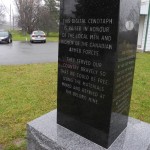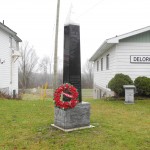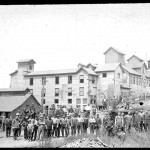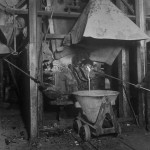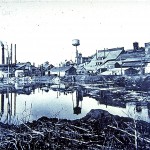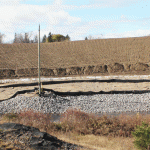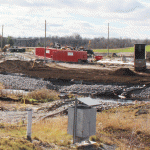By Mo Cranker [8]
DELORO – During Remembrance Week it is usually the men and women who went overseas who are honoured, while those who served on the home front are sometimes forgotten.
One of the key contributors to Canada’s war efforts for almost half a century was the tiny village of Deloro, located just north of Highway 7 [9] between Madoc [10] and Marmora [11].
A brand-new interactive cenotaph in Deloro honours both those who fell in war and also those who worked at the Deloro Smelting and Refining Company [12].
The four-metre-high granite obelisk is topped with a cone made of the metal stellite [13], in honour of the men and women who helped produce that metal for the war effort at the Deloro company.
“When we first moved to the village, we heard about the contributions that the Deloro mine made to the world wars, specifically in defeating Hitler,” said Laura Forth, one of the people responsible for the new Deloro cenotaph. “We decided that we wanted to do a monument to honour Canadian Armed Forces personnel and also the men and women who worked in the Deloro mine.”
Deloro’s history as a metal refinery began around the time of Confederation, when gold was discovered at the nearby hamlet of Eldorado [14] and subsequently in Deloro and other spots in central Hastings County [15].
Because Deloro was established as a place for gold to be refined, it was the perfect place for smelting and refining silver ore that was mined in Cobalt, Ont. [16] The silver ore was turned into stellite, a metal that can withstand the most extreme heat. But the refining process was dangerous for workers, because highly toxic metals such as arsenic were byproducts of the process.
During the world wars the stellite produced in Deloro was used to create munitions. The stellite was also used in aircraft engines during the Korean War [17].
The new cenotaph in Deloro was dedicated last month. It is being called the world’s first digital cenotaph; a QR code [18] on it allows visitors with smartphones or tablets to see a video about the history of the Deloro operation and its place in Canada’s war effort.
On Remembrance Day, Deloro resident Ken Spry was one of the people who gathered at the cenotaph to pay respect to those who fought during the wars and to those who worked at the Deloro smelting plant. Among the latter were Spry’s father, both his grandfathers and three of his uncles.
“The men that worked in this mine suffered very severely working with arsenic and other types of minerals so that metal could be made – so that we had planes and ammunition so that we could fight in the First and Second World Wars and the Korean War,” Spry told QNet News. “They sacrificed their life just like the men that went overseas to win the wars.”
Roy Bowles, an emeritus professor of sociology at Trent University [19], did a study of the village of Deloro with a group of students in the 1970s. He says the men and women who worked in the mine should not be forgotten when we pay tribute to those who contributed to the war effort.
“The workers in the plant were exposed to very hazardous circumstances, and some became ill and some died as a consequence of the working conditions,” Bowles said in an interview at his home in Lakefield, Ont., this week. “Those people that worked in the plant at the Deloro Smelting and Refining company were exposed to risks as serious as the battlefield, and made a contribution as important as much of the battlefield operation.”
The Deloro mine and smelting operation was abandoned in the early 1960s. The site, hugely contaminated with arsenic and other toxic and radioactive wastes, is undergoing a years-long cleanup [20] spearheaded by the Ontario Ministry of the Environment.
